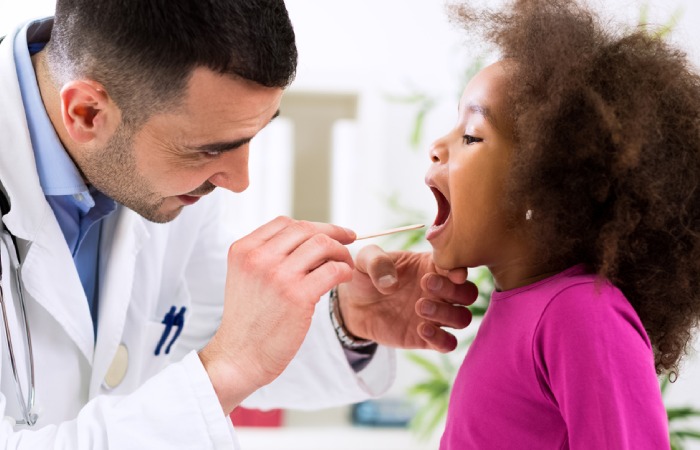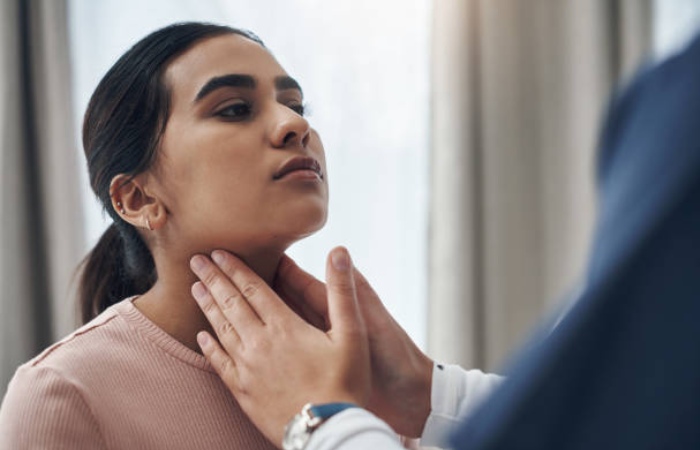How Is Sore Strep Throat Symptoms In Adults Identified
If you think you may have strep throat, you should see a doctor. The worker will ask you queries about your symptoms and perform a physical exam. You can also take a strep test. Viral diseases can have the same symptoms as sore strep throat symptoms in adults. This is why it is essential to take a strep test to confirm the attendance of group A strep bacteria in your throat.
What is a strep test?
A strep throat test will detect group A strep bacteria in the throat. The test is painless, although it may be uncomfortable for some people, and takes very little time. A doctor will use the tip of a long, specialised cotton swab to clean the back of the throat. The provider will then use the swab to do a rapid strep test or send the pad to a workroom for testing (throat culture).
A rapid strep test takes around 20 minutes. If the test is positive (the swab controlled Streptococcus bacteria), you drink strep throat. If the test is negative (no cyphers of strep on the swab), you may not have strep throat. However, the provider may send the strep throat symptoms in adults web to a laboratory to verify the results with a throat culture.
Management and treatment
How to get rid of strep throat?
Treatment for strep throat comprises antibiotics. An antibiotic is a type of drug that kills the bacteria that causes an infection.
Penicillin and amoxicillin are common antibiotics that doctors use to treat strep throat. If you are allergic to penicillin, your provider may prescribe another antibiotic.
A healthcare professional may give you an antibiotic injection or prescribe an antibiotic in pill or liquid form. Typically, you will take the tablets or liquid for ten days. Follow your supplier’s instructions. You should take all your medications, even if you feel better. Bacteria can stay alive even if you feel well.
How can I develop rid of strep throat symptoms in adults overnight?
Unfortunately, strep throat cannot be cured overnight. A type of bacteria causes strep throat. Therefore, you need an antibiotic to eliminate it. After you start taking an antibiotic, you should begin to feel better within a day or two. In the meantime, there are steps you can take to manage your symptoms, such as drinking warm fluids and taking pain relievers.
In the case of a throat culture, a laboratory technician spreads the swab onto a culture dish. It takes a day or two to see if the Streptococcus bacteria is growing there. Strep throat symptoms in adult cultures can sometimes detect bacteria that are not detected by rapid strep tests.
A sore strep throat symptoms in adults is a common problem and is usually instigated by a viral or bacterial infection. The medical term for a painful throat is “pharyngitis.” It usually goes away on its own without complications in adults, although it is essential to know when to see a doctor.
Viruses can cause sore throats and other upper respiratory infections, such as the common cold. A sore throat caused by the cold virus is not treated with antibiotics but can be treated with rest, pain relievers, and other therapies aimed at relieving symptoms.
Strep throat is an exact type of pharyngitis produced by a bacteria known as group A streptococcus (GAS). Strep throat is treated with a sequence of antibiotics.
A topic on sore throats in children is available separately.
Also Read : WELLHEALTH AYURVEDIC HEALTH TIPS
Symptoms Of Sore Strep Throat Symptoms In Adults

Viral pharyngitis: Most people with sore throats are infected with a virus. The most common viruses are those that cause upper respiratory infections, such as the common cold. (See “Patient Education: The Cold in Adults (Beyond the Basics).”)
Symptoms of a viral infection may include:
- Runny or stuffy nose
- Irritation or redness of the eyes.
- Cough, cakiness or pain in the roof of the mouth.
Some viruses cause fever and can make you very sick.
Strep throat: About 10 per cent of adults with a sore throat have strep throat. The signs and symptoms of strep throat include the following (Figure 1):
- Sore throat
- Fever (temperature above 100.4°F or 38°C)
- Enlarged lymph glands in the neck.
- White spots of pus on the side or back of the throat
- No cough, runny nose or eye irritation/redness.
Other infections: Many other less common infections can cause sore throat, such as mononucleosis (mono), influenza (flu), Neisseria gonococcus (gonorrhoea), human immunodeficiency virus (HIV), and others. A sore strep throat symptoms in adults can also be a symptom of coronavirus disease 2019 (COVID-19). (See “Patient Education: HIV Symptoms (Beyond the Basics)”, “Patient Education: Gonorrhea (Beyond the Basics)”, and “Patient Education: Flu Symptoms and Treatment (Beyond the Basics) Basics)” and “Patient Education: Infectious Mononucleosis (Mono) in Adults and Adolescents (Beyond the Basics)
When to seek urgent help: See your doctor or nurse immediately if you have a sore throat with any of the following symptoms:
- Difficulty breathing
- Skin rash
- Yawn because you can’t swallow
- Swelling of the neck or tongue.
- Stiff neck or difficulty opening your mouth.
- Underlying chronic illness/medications that may affect your immune system.
You should also contact your healthcare professional for advice if you think you may have been exposed to the virus that causes COVID-19. (See “Could You Have COVID-19?” below.)
DIAGNOSIS OF SORE THROAT

Most people with sore strep throat symptoms in adults get better without treatment. There is no specific treatment for sore throats caused by cold viruses.
Is it strep or not? — A combination of symptoms (fever, enlarged glands in the neck, white spots on the tonsils, and lack of cough) can help determine if you have strep. If you have two or more symptoms, you may have a rapid test or throat culture. People with fewer than two symptoms generally do not need testing or treatment for strep throat, although they may benefit from treatment that includes modalities to reduce symptoms.
Rapid test: The quick test determines if there is Streptococcus bacteria in a throat swab. The quiz can be performed in a doctor’s workplace, and results are available within minutes. The test is accurate in most cases, although a small percentage of tests are false negative (bacteria is present, but the test is negative).
Throat culture: A throat culture involves taking a swab of the strep throat symptoms in adults, sending the sample to a workroom, and waiting 24 to 48 hours for results. Throat cultures are slightly more accurate than the rapid test.
Could you have COVID-19? — It is essential to get tested for coronavirus disease 2019 (COVID-19) if you have a sore throat, even if you have already been vaccinated or had COVID-19. Contact your healthcare professional; They can tell you if you need to be seen or go elsewhere to get tested. The Centers for Disease Control and Prevention also provides helpful recommendations on how and when to test for suspected COVID-19.
TREATMENT OF SORE THROATS
Treating a sore throat: Antibiotics do not relieve painful strep throat symptoms caused by a virus in adults and are not recommended. Unsuitable use of antibiotics for the treatment of viral illnesses may unnecessarily increase the risk of side effects such as diarrhoea, rash, or more serious allergic reactions. Sore throats caused by viral infections usually last four to five days. During this time, treatments aimed at reducing pain may be helpful. Several therapies can help relieve a sore throat.
Pain medications: Over-the-counter pain relievers can provide quick and effective relief from a sore throat. These include acetaminophen (example brand name: Tylenol) or a nonsteroidal anti-inflammatory medication (“NSAID”) such as ibuprofen (example brand name: Advil, Motrin) or naproxen (example brand name: Aleve, Naprosyn).
Oral steroids are not used routinely because they have (potentially serious) side effects, the benefits of treating sore throats are limited, and over-the-counter treatments are helpful in most cases.
Mouthwashes: Salt water gargles have long been used as a remedy for sore strep throat symptoms in adults. It is uncertain whether salt water relieves pain, but it is unlikely to be harmful. Most formulae suggest 1/4 to 1/2 teaspoon (1.5 to 3.0 g) of salt per 1 cup (8 grains or 250 ml) of warm water.
Aerosols: Aerosols containing topical anaesthetics (e.g., benzocaine, phenol) are available to treat sore strep throat symptoms in adults. However, these sprays are no more effective than sucking on hard candies.
Alternative therapies: Health food stores, vitamin outlets, and websites offer alternative treatments to relieve a sore throat. We do not recommend these types of treatments due to the risk of pesticide/herbicide contamination, incorrect labelling and dosage information, and lack of studies demonstrating that these treatments are safe and effective.
Strep throat: Although strep throat usually resolves on its own within two to five days, antibiotic treatment is recommended for adults who have a positive rapid test or throat culture for strep throat symptoms in adults.
PREVENTION OF SORE THROAT
Hand washing is an essential and very effective way to prevent the spread of infections. Wet your hands with plain soap and water and clean them together for 15 to 30 seconds. Pay particular care to the nails between the fingers and the wrists. Rinse your hands well and dry them with a clean towel.
Alcohol-based hand sanitisers are a good alternative for disinfecting your hands if a sink is not available. Hand sanitisers should be spread over the entire surface of the hands, fingers and wrists until they are dry and can be used multiple times. These frictions can be used repeatedly without skin irritation or loss of effectiveness. Hand sanitisers are available in liquid or wipe form in small, portable formats that are easy to carry in a pocket or bag. Where a sink is available, visibly dirty hands should be washed with soap and water.
Wash your hands after coughing, gusting your nose or sneezing. Although it is not always possible to avoid being near a sick person, avoid touching your eyes, nose, or mouth to stop the spread of infection.
Additionally, disposable tissues should be used to cover your mouth when sneezing or coughing. These used tissues should be thrown away quickly. Sneezing/coughing into your sleeve (inside your elbow) is another way to contain saliva splashes and secretions and will not contaminate your hands.
Additional Common Questions
Can You Get Strep Throat Symptoms In Adults Without Tonsils:
Strep throat usually affects the throat and tonsils. But you can still get the contagion if you don’t have tonsils; This does not make you immune. However, if you have had your tonsils removed, your risk of getting strep strep throat symptoms in adults decreases. You may contact the infection less often. Additionally, your symptoms may not be as severe.
Other sore throats don’t require particular medications, so why get strep throat?
Viruses cause most sore strep throat symptoms in adults, and medications (such as antibiotics) cannot cure viruses. You can only relieve your pains and pains. Worms heal themselves over time without antibiotics. Since strep throat is a microbial infection, antibiotics are needed to cure it.
Can I take antibiotics that I already have at home for strep throat?
No. It would help if you never took medicines from a previous illness or gave them to anyone else. Leftover antibiotics can also make strep strep throat symptoms in adults more challenging to treat and cause serious side effects.
What is the difference between strep throat and tonsillitis?
Tonsillitis occurs when the tonsils become inflamed or infected. The disease can be viral or bacterial. Viruses cause most cases of tonsillitis. Bacteria such as group A streptococcus cause other cases.





